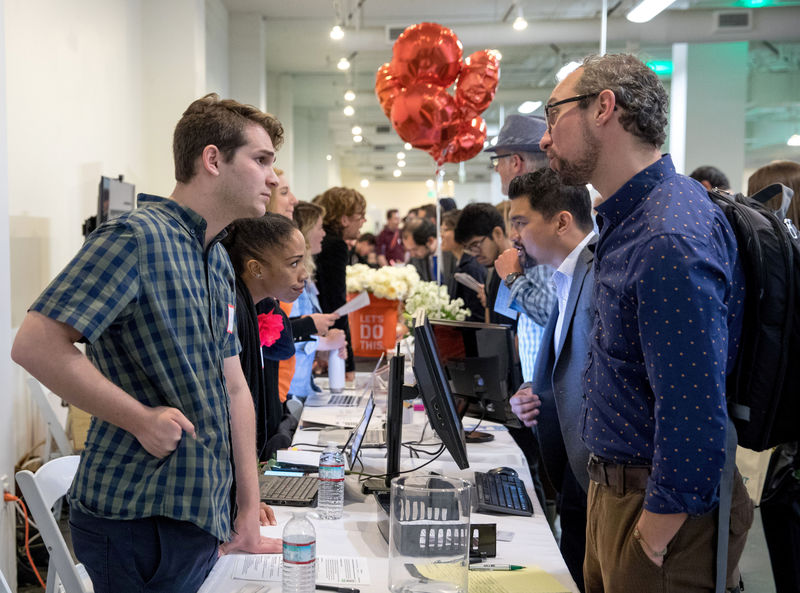By Lucia Mutikani
WASHINGTON, (Reuters) - The U.S. economy created the fewest jobs in six months in March as a boost from milder temperatures faded, but a pickup in wage gains pointed to a tightening labor market, which should allow the Federal Reserve to further raise interest rates this year.
Nonfarm payrolls increased by 103,000 last month, with construction and retail sectors shedding jobs, the Labor Department said on Friday. That was the smallest gain since last September and followed a 326,000 surge in February, which was the largest in more than two years.
Temperatures returned to normal in March, with snowstorms in some parts of the country. The pullback in job gains is likely temporary as layoffs are at historic lows and other independent labor market indicators were strong in March.
"Inclement weather was the primary culprit for the slowdown in the pace of job growth in March," said Joseph Song, an economist at Bank of America Merrill Lynch (NYSE:BAC) in New York.
Employment gains averaged 202,000 jobs per month in the first quarter, highlighting underlying labor market strength. The economy needs to create roughly 100,000 jobs per month to keep up with growth in the working-age population.
The unemployment rate held steady at 4.1 percent for a sixth straight month. Economists polled by Reuters had forecast the economy adding 193,000 jobs in March and the unemployment rate dropping to 4.0 percent.
A broader measure of unemployment, which includes people who want to work but have given up searching, and those working part time because they cannot find full-time employment, fell two-tenths of a percentage point to 8.0 percent last month.
With labor market slack diminishing, wage growth picked up a bit in March. Average hourly earnings rose eight cents or 0.3 percent last month after edging up 0.1 percent in February.
The gain lifted the annual increase in average hourly earnings to 2.7 percent from 2.6 percent in February. Annual wage growth is inching closer to the pace of at least 3 percent economists say is needed to lift inflation toward the Fed's 2 percent target.
Fed Chairman Jerome Powell told the Economic Club of Chicago on Friday that lack of robust wage gains suggested the labor market was not "excessively tight" and that he would be "looking for an additional pickup in wage growth as the labor market strengthens further."
The U.S. central bank increased borrowing costs last month and forecast two more interest rate hikes this year.
"In sum, no change in the Fed's trajectory," said Steven Blitz, chief U.S. economist at TS Lombard in New York. "If anything, the wage data are beginning to strengthen the argument for three more hikes this year."
The step-down in employment gains combined with mounting trade tensions between the United States and China to undercut stocks on Wall Street and the dollar.
Beijing warned on Friday it was fully prepared to respond with a "fierce counter strike" of fresh trade measures if Washington followed through with President Donald Trump's threat to slap tariffs on an additional $100 billion in Chinese goods.
U.S. stocks tumbled, with the Dow Jones Industrial Average falling 650 points, or 2.6 percent. The dollar weakened against a basket of currencies and U.S. Treasury prices rose.
MODEST ACCELERATION FOR THE ECONOMY
Economists do not see an impact on hiring in the near term from the stock market selloff, which has caused a tightening in financial conditions.
While the weather dampened hiring last month, it did not have an impact on hours worked. The average workweek held at 34.5 hours. That together with the modest job gains and increase in average hourly earnings boosted a proxy for take-home pay.
"This morning's figures may suggest a little less momentum heading into the second quarter, but taken with other data, the continued expansion in total hours worked points to a modest acceleration in activity this quarter, provided we manage to avoid shooting ourselves in the foot on trade policy," said Michael Feroli, an economist at JPMorgan (NYSE:JPM) in New York.
The economy appears to have slowed in the first quarter, with gross domestic product growth estimates mostly below a 2 percent annualized rate. Growth in the January-March period tends to be weak for seasonal reasons.
The economy grew at a 2.9 percent pace in the fourth quarter. Growth this year is seen bolstered by a $1.5 trillion income tax cut package and increased government spending, which economists say will offset some of the impact from the stock market's gyrations.
The unemployment rate has hovered at 4.1 percent since October as people piled into the labor market. The labor force participation rate, or the proportion of working-age Americans who have a job or are looking for one, slipped one-tenth of a percentage point to 62.9 percent in March after rising to a five-month high of 63.0 percent in February.
The return of cold weather and a shortage of skilled workers weighed on hiring at construction sites in March. Payrolls in the sector fell 15,000, the first drop since last July, after surging 65,000 in February.
Manufacturing employment increased 22,000. The retail sector shed 4,400 jobs after adding 47,300 positions in February.
Temporary help, seen as a harbinger of future permanent hiring, slipped by 600. Leisure and hospitality employers added only 5,000 jobs last month, the least since September. Government payrolls rose by 1,000 in March.
